Betty - Another Cambridge "girl"
by Mark Nye
Issue No. 131 - March 1984
Of the "Cambridge Girls," two can be called "Mystery Girls." They are Marlene and Betty. In a future article, Marlene will be discussed. For now, we turn our attention to Betty. Unfortunately, this article will leave unanswered more questions than it answers.
 We do know Betty was advertised in March, 1920, as new. The "birth"
announcement appeared in the Crockery and Glass Journal. The
appearance of the word NEW did not always mean new that month, and
actual introduction may have taken place several months prior to the
advertisement. My guess would be that Betty was introduced to the trade
via trade shows ear1ier in the year.
We do know Betty was advertised in March, 1920, as new. The "birth"
announcement appeared in the Crockery and Glass Journal. The
appearance of the word NEW did not always mean new that month, and
actual introduction may have taken place several months prior to the
advertisement. My guess would be that Betty was introduced to the trade
via trade shows ear1ier in the year.
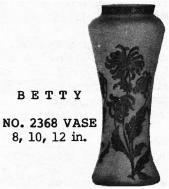 In addition to
the readily distinguishable big flowers and leaves, the Betty etching
also has a border around the top rim of each piece. This border
consists of a repetitive small leaf and flower design. Border is shown at
right.
In addition to
the readily distinguishable big flowers and leaves, the Betty etching
also has a border around the top rim of each piece. This border
consists of a repetitive small leaf and flower design. Border is shown at
right.
Betty appeared in a Cambridge catalog bearing the Nearcut trademark and issued circa 1922. Betty (shown on two pages of this catalog) was limited to vases, a pitcher and a tumbler. The price list that accompanied the catalog verified this was all the pieces of Betty being offered at that time.
The first catalog page (reprinted in Welker I, page 97) shows twelve different vases etched Betty. Adding up the various sizes and styles, a total of 29 vases were available with the Betty etching. If you want a real challenge, put together a collection of all 29!!
On the second catalog page, a pitcher is shown and listed as the #110 4 pint jug, as well as the #1415 10 oz. tumbler. These items are shown at left.
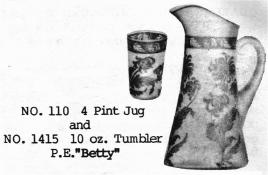
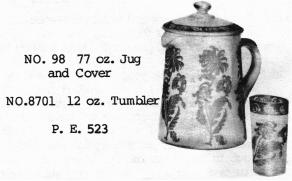 Now, the mystery begins! On the same catalog page that illustrated
the Betty jug, there was shown the #98 77 oz. jug and cover, along with
the #8701 12 oz. tumbler, both etched P.E. 523 (shown at right). Nothing startling about
that except for the fact that Plate Etching 523 appears to be the same
as Betty! Granted, the border part of the etching appears on the lid,
not on the top of the pitcher, but other than that, I can discern no
difference between Betty and P.E. 523.
Now, the mystery begins! On the same catalog page that illustrated
the Betty jug, there was shown the #98 77 oz. jug and cover, along with
the #8701 12 oz. tumbler, both etched P.E. 523 (shown at right). Nothing startling about
that except for the fact that Plate Etching 523 appears to be the same
as Betty! Granted, the border part of the etching appears on the lid,
not on the top of the pitcher, but other than that, I can discern no
difference between Betty and P.E. 523.
One possible explanation for this is, like several other instances, perhaps the etching had a popular name as well as a factory assigned number and the number was inadvertently used in place of the name under the catalog illustration and in the price list, for P.E. 523 also appeared there. However, it is entirely possible that there are differences between Betty and P.E. 523 that are not readily seen in the catalog illustration.
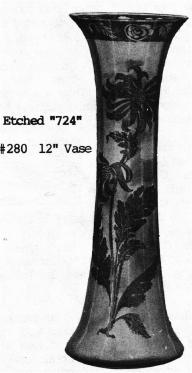 But wait! Our Betty is really a mysterious lady. By the late 1920s,
it seems she may have gone incognito, calling herself Etching 724. See
illustration at left. A
catalog page from that era, reprinted by the Welkers in their Book I of
catalog reprints (page 90) shows three vases etched with what
appears to be Betty, yet is captioned P. E. 724. Two of the
three vases also appeared in the Nearcut era catalog as Betty. All
three vases are shown on the former catalog page with flower holder
inserts, but that would not effect the etching designation.
But wait! Our Betty is really a mysterious lady. By the late 1920s,
it seems she may have gone incognito, calling herself Etching 724. See
illustration at left. A
catalog page from that era, reprinted by the Welkers in their Book I of
catalog reprints (page 90) shows three vases etched with what
appears to be Betty, yet is captioned P. E. 724. Two of the
three vases also appeared in the Nearcut era catalog as Betty. All
three vases are shown on the former catalog page with flower holder
inserts, but that would not effect the etching designation.
What's this? A new disguise perhaps? The border is gone but the etching "Chrys" (no doubt short for chrysanthemum) certainly looks like Betty. We first find "Chrys" on an ice bucket, shown on a page from the same late 1920s catalog and again reprinted by the Welkers. As with the P.E. 724 illustration, the etching is not distinct, but yes, it certainly does resembles Betty. If only we could get another look!
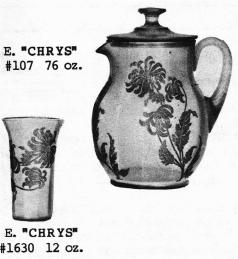 Our wishes are granted ... for in the NCC 1930-34 Catalog Reprint,
we once again find both E. 724 and "Chrys", but this time on pages
dating to 1930. The illustrations are clear and we get a good look at
both etchings. "Chrys" appears on an ice pail #1121 and on a covered
jug and tumbler (at right). Etch 724 shows up on five different vases. After
allowing for positioning the etchings on varying shaped items of
different sizes, the only readily discernible difference between the
two is the border used in E. 724. Nor is there any easily seen
differences between E. 724 and Betty.
Our wishes are granted ... for in the NCC 1930-34 Catalog Reprint,
we once again find both E. 724 and "Chrys", but this time on pages
dating to 1930. The illustrations are clear and we get a good look at
both etchings. "Chrys" appears on an ice pail #1121 and on a covered
jug and tumbler (at right). Etch 724 shows up on five different vases. After
allowing for positioning the etchings on varying shaped items of
different sizes, the only readily discernible difference between the
two is the border used in E. 724. Nor is there any easily seen
differences between E. 724 and Betty.
The 1930 catalog page is the last reference I have found to Betty in any of her disguises.
Are there differences between Betty, P.E. 523, E. 724, and "Chrys", other than the borders, and if so, what are they? In ten words or less ... "I don't know!"
One infrequently sees this group of etchings, regardless of the name, and thus, there is great difficulty in becoming familiar with sufficient items to discern any differences, significant or minute.
"Chrys" and E. 724 were no doubt done in most, if not all of the prevailing colors of the later 1920s and early 1930s. "Chrys", the easiest to identify and find was recently seen at a show on light emerald green and Peach-Blo pitchers. Betty and P.E. 523 would have been made in crystal and perhaps in color as well.
Betty, the mysterious Cambridge Lady, remains an enigma.
